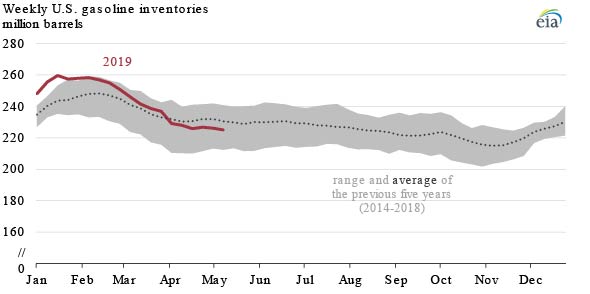
Heading into the 2019 Memorial Day weekend, regular gasoline prices averaged $2.85 per gallon (gal) nationally on May 20, slightly lower than last year’s price of $2.92/gal before the holiday weekend.

EIA expects U.S. regular retail gasoline prices will increase in the coming months and average $2.92/gal during the 2019 summer season (April through September), 7 cents/gal higher than last summer, according to EIA’s May Short-Term Energy Outlook. Although crude oil spot prices are expected to remain lower than price levels from last year, higher gasoline demand, lower gasoline inventories, and higher gasoline refining margins will likely result in higher retail gasoline prices this summer.
Gasoline prices typically increase during the spring because of the mandated switch from winter-grade gasoline to more expensive summer-grade gasoline. This year, the average price for regular gasoline has increased by 16 cents/gal (6%) since the start of April, lower than last year’s increase of 22 cents/gal (8%).
Higher gasoline consumption is putting additional upward pressure on prices. As of May 10, 2019, the four-week average U.S. gasoline demand was 9.4 million barrels per day (b/d), about 0.5% higher than last year’s levels. AAA (in association with IHS Markit) expects more than 37 million Americans will travel by car this weekend, 3.5% more travelers than last year and the highest travel volume since 2005.
Decreasing gasoline inventories, including finished gasoline and gasoline blending components, are also contributing to the increase in gasoline prices. Although gasoline inventories started the year higher than normal (based on the range of seasonal values in the previous five years), they have since decreased to below-average levels.

U.S. petroleum product price movements tend to follow the international benchmark Brent crude oil spot price. Although the Brent price has increased since the beginning of 2019, it remains below its value at this time last year. Brent crude oil averaged $71.25 per barrel (b) the week of May 10, 2019, or 7% lower than the same week in 2018. EIA expects Brent crude oil prices during the 2019 summer season to average near $73/b, or $2.31/b lower than last summer. When converted from barrels to gallons, this amount equals an almost 6 cent/gal decrease in crude oil prices.
The U.S. Gulf Coast region, defined as Petroleum Administration for Defense District (PADD) 3, generally has the lowest retail gasoline prices in the country. This year to date, Gulf Coast gasoline prices have averaged 30 cents/gal lower than the national average.
By contrast, the West Coast (PADD 5) region typically has the highest regional average gasoline prices, averaging 67 cents/gal higher than the national average so far this year. The West Coast has recently seen a sharper increase in retail gasoline prices than the rest of the United States, pulling up the national average. West Coast retail gasoline prices are typically the highest in the country because of the region’s tight supply and demand balance, isolation from additional supply sources, and gasoline specifications that are more costly to meet. This year, planned and unplanned refinery outages and relatively low gasoline inventories have also affected West Coast gasoline prices.





Follow us on social media: